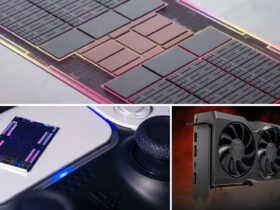Daftar Isi
In the ever-evolving world of computer graphics, ray tracing has emerged as a game-changer. This rendering technique, once confined to high-end workstations, is now making its way into mainstream gaming and entertainment. Let’s unravel the magic of ray tracing, explore its impact on visual realism, and understand why it’s a buzzword in modern GPUs.
Exploring the Fundamentals of Ray Tracing: Unveiling the Magic of Virtual Lighting
Ray tracing, at its essence, serves as the cornerstone of modern graphics rendering, captivating audiences with its ability to mimic the intricate interplay of light in virtual environments. To understand this new graphic innovation is to embark on a journey into the heart of digital artistry, where pixels transform into vibrant scenes teeming with life and realism.
A Basic Concept
Imagine yourself standing in a virtual room bathed in sunlight filtering through a window. Each ray of light interacts with the objects within the space, casting shadows that dance across the floor, creating reflections that shimmer on polished surfaces, and bouncing off materials to illuminate the environment with a lifelike glow. This intricate ballet of light and shadow is the essence—a sophisticated technique that simulates the behavior of light to render visually stunning and immersive scenes.
Revolution in Digital Graphic World
Ray tracing revolutionizes the world of digital graphics by imbuing virtual environments with a level of realism and authenticity previously unattainable. From the subtle interplay of light and shadow to the breathtaking reflections and refractions that bring scenes to life, it elevates visual storytelling to new heights, captivating audiences with its unparalleled fidelity and depth.
As technology continues to advance and the boundaries of what is possible in digital rendering expand, it remains at the forefront of innovation, driving the evolution of gaming, film, architecture, and beyond. With each pixel meticulously illuminated by the magic of ray tracing, the boundaries between the virtual and the real blur, inviting us to immerse ourselves in worlds limited only by our imagination.
Read More: Intel Arc: Intel’s Latest Endeavor in the GPU Field
Demystifying Ray Tracing: A Deep Dive into Cutting-Edge Graphics Technology
Ray tracing stands as a marvel of modern graphics technology, revolutionizing the way we perceive and interact with virtual environments. At its core, this technology operates as a sophisticated rendering technique that meticulously simulates the behavior of light rays within a digital space, resulting in stunningly realistic visuals that captivate audiences around the globe. To grasp the inner workings of this graphic innovation is to unravel the intricacies of digital artistry and witness the magic of light come to life in ways previously thought impossible.
Ray Generation: Illuminating the Scene
At the heart of ray tracing lies the process of ray generation. For every pixel displayed on the screen, a virtual ray is cast from the viewer’s eye, known as the viewport, into the digital scene. This foundational step forms the basis for rendering each frame, allowing the viewer to perceive the virtual world from their unique perspective.
As the virtual ray traverses the digital landscape, it encounters objects within the scene, ranging from walls and furniture to characters and complex architectural elements. Through rigorous intersection testing, the ray determines which objects it intersects with, effectively mapping out the visual composition of the scene and laying the groundwork for what the viewer ultimately perceives.
Light Interaction: Illuminating the Depths
With each intersection, the ray continues its journey, interacting with surfaces, refracting through transparent materials, and calculating the intricate interplay of light at every point along its path. This dynamic process simulates the complexities of real-world lighting conditions, allowing for the accurate portrayal of reflections, refractions, and shadows that lend depth and realism to the virtual environment.
Pixel Color Calculation: Crafting the Final Image
As the ray completes its traversal through the digital realm, the final color of each pixel is meticulously calculated based on a multitude of factors, including surface properties, light sources, material properties, and environmental conditions. This intricate pixel color calculation ensures that each frame is rendered with unparalleled fidelity and accuracy, resulting in visuals that are as breathtaking as they are immersive.
In essence, this technology transcends the realm of mere graphics rendering, offering a gateway to boundless creativity and artistic expression in the digital landscape. With each pixel meticulously illuminated by the magic of ray tracing, the boundaries between fantasy and reality blur, inviting viewers to embark on a journey where imagination knows no bounds.
Realism Unleashed: Ray Tracing’s Impact
Gaming and Cinematics
- Real-Time Ray Tracing: Thanks to advancements in hardware and software, real-time ray tracing is now achievable. Games like Cyberpunk 2077, Control, and Minecraft showcase stunning visuals with realistic lighting, reflections, and shadows.
- Cinematic Storytelling: In film and animation, ray tracing elevates visual storytelling. From Pixar’s animated movies to high-budget blockbusters, ray-traced scenes immerse audiences in lifelike environments.
Architectural Visualization and Design
- Architectural Previews: Architects and designers use ray tracing to create realistic previews of buildings and interiors. It helps clients visualize spaces before construction begins.
- Product Design: Ray tracing aids in product design by simulating how light interacts with materials. From car paint to jewelry, accurate reflections and lighting enhance the design process.
In conclusion, ray tracing isn’t just a buzzword; it’s a paradigm shift. As GPUs continue to evolve, ray tracing will redefine our digital experiences, blurring the line between virtual and reality.
































